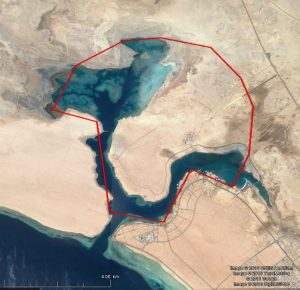Location: 24.15323N 37.93766E
Let’s first go back to the initial description of this port by Agatharchides of Cnidus, in “On the Erythrean Sea” (text lost, around 140 BC), after Diodorus of Sicily (Hist, 3, 21, around 40 BC), translated by BURSTEIN, S. (1989) « Agatharchides of Cnidus – On the Erythraean Sea », The Hakluyt Society, London, (202 p):
Travelling along the Arabian coast from north to south:
“[…] This coast, then, is occupied by the Arabs called Thamoundeni. A good sized gulf occupies much of the next segment of coast. Scattered islands lie off it which are in appearance similar to the Echinades [islands near Oeniades, now Katoxi, Greece]. The next part of the coast is dominated by dunes which are infinite in their length and breadth and black in colour. After these dunes, a peninsula and harbour named Charmuthas, the finest of those known in history, come into view. For behind a superb breakwater, which inclines towards the west, there is a gulf which is not only remarkable in appearance but also far surpasses others in its advantages. A densely-wooded mountain range extends along it and encircles it on all sides for a 100 stades [15 to 20 km, depending on the length of a stadium]. Its entrance is 200 feet wide [60 m], and it furnishes a sheltered harbour for 2000 ships. In addition to these advantages, it has an extremely good supply of fresh water since a large river flows into it. Also, in the middle of the gulf there is an island which has a good supply of fresh water and is able to support gardens. In general, it is very similar to the harbour at Carthage which is called Cothon … A multitude of fish from the sea congregate in it because of its calmness and sweetness of the waters that flow into it. […]”

Sharm Yanbu, located 15 km north of Yanbu (S. Arabia) is close to Diodorus’ description:
- the total circumference is 23 km (close to his 100 stades);
- the central island might be now connected to the mainland on the NE side where siltation occurred over time, near the outlet of the wadi;
- the total area might have been between 2000 and 3000 ha (ample space for his 2000 ships);
- the entrance is now 300 m wide (more than his 200 feet = 60 m) but this depends much on coral growth which may have varied in time and with urbanisation.
No archaeological remains are known so far and it might be worth having a look around …